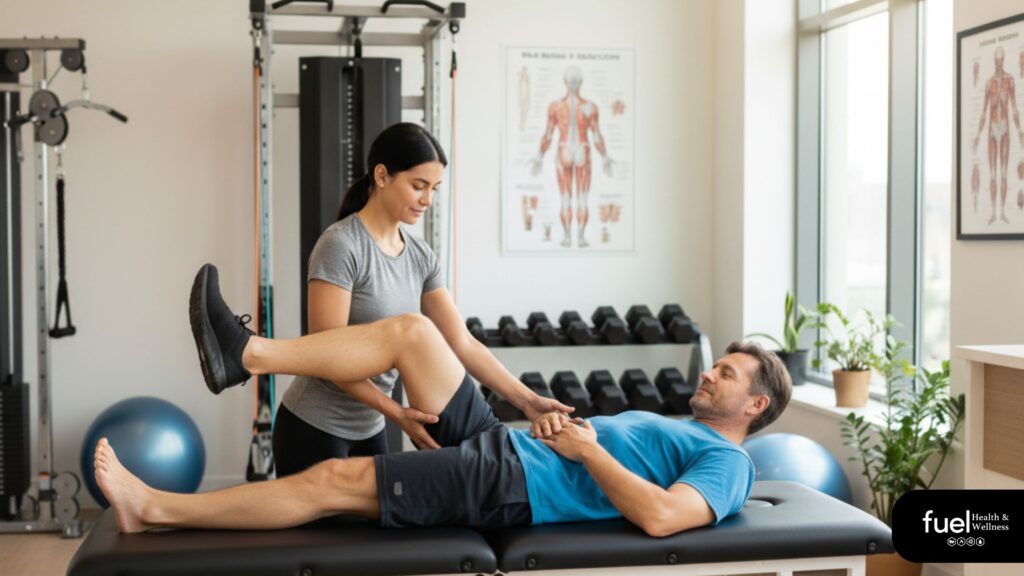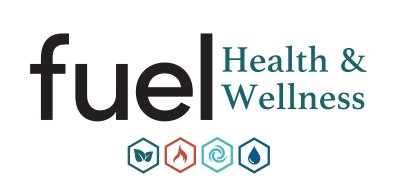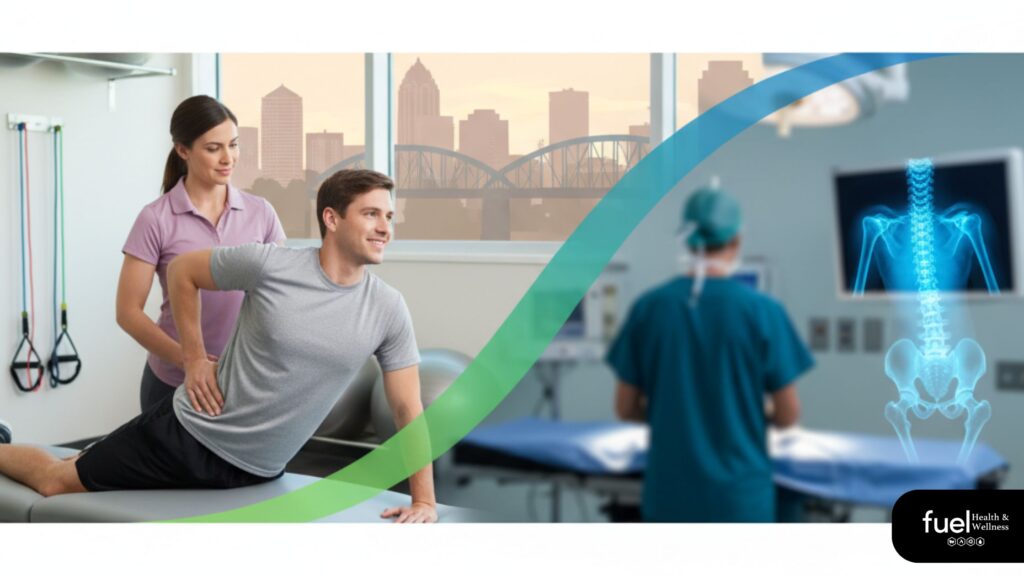Back pain is a common companion for over 80 percent of adults, and deciding between gentle physical therapy and more involved surgery can feel like a daunting task. This guide is here to shed light on what causes back pain, how physical therapy works its magic, when surgery might be the right path, and the non-surgical options available right here in Grand Rapids. You’ll discover:
- The roots, types, and daily impact of back pain
- Physical therapy techniques, their benefits, and the best timing
- Surgical approaches, their risks, and how recovery stacks up
- Key factors for making your decision and preparing for surgery
- Local non-surgical treatments, holistic wellness, and your next steps
Whether you’re aiming to ditch the discomfort or boost your movement, Fuel Health and Wellness champions a holistic approach to back pain. We combine expert assessments with personalized recovery plans, guiding you from your first evaluation all the way to lasting relief.
What Sparks Back Pain and How Does It Show Up?
Back pain often stems from strained muscles, pinched nerves, or changes in the spine’s structure. These underlying issues can weaken your posture, ignite inflammation, and limit your ability to move freely, ultimately leading to pain and a dip in your quality of life. For instance, a herniated disc can press on nearby nerves, causing pain that shoots down your leg, perfectly illustrating how your body’s mechanics and anatomy can team up to create discomfort.
What Are the Usual Suspects When It Comes to Back Pain Types and Symptoms?
We typically categorize back pain into a few main types: acute (short-lived), chronic (lingering for over three months), mechanical (tied to spine movement), and radicular (nerve-related). Your symptoms will likely vary depending on the type:
- A sharp, stabbing sensation in your lower back when you bend or lift
- Pain that travels down your leg, or numbness, if you have sciatica
- A dull, constant ache that gets worse when you sit or stand for too long
- Muscle spasms and stiffness that make it hard to bend or twist
Often, these symptoms can overlap, signaling the need for a treatment plan that’s as unique as you are, focusing on both easing your pain and tackling the root cause.
Which Back Pain Conditions Can Physical Therapy Help You Conquer?

Physical therapy is a powerhouse for treating a variety of back conditions by helping you regain movement, dial down inflammation, and build up your supporting muscles. Some key conditions it can help with include:
- Muscle strains and ligament sprains
- Herniated or bulging discs
- Sciatica and nerve root compression
- Spinal stenosis and joint degeneration
Research shows that physical therapy is a highly effective non-surgical route for managing chronic, non-specific low back pain, significantly cutting down pain and improving how well you function. For herniated discs, physical therapy can ease symptoms, boost mobility, and help prevent them from coming back through targeted exercises and hands-on techniques. (pmc.ncbi.nlm.nih.gov)
Each condition benefits from customized therapeutic exercises and manual techniques designed to address its specific biomechanical and neurological factors.
How Does Back Pain Mess With Your Daily Life and Movement?
When back pain sticks around, it can really throw a wrench in your everyday activities, making it tough to:
- Get up from a chair or climb stairs
- Carry groceries or lift your children
- Reach or twist with ease
- Sleep soundly through the night
These challenges can pile up, impacting your work, social life, and overall sense of well-being—which is why getting timely, effective help is so crucial.
What Exactly Is Physical Therapy and How Does It Tackle Back Pain?
Physical therapy is a non-invasive approach that uses movement, hands-on techniques, and education to improve your body’s alignment, reduce pain, and rebuild your functional strength. By combining specific exercises with manual therapies, our therapists address underlying imbalances in your musculoskeletal system and teach you how to keep pain at bay long-term. This evidence-based method not only eases your current discomfort but also promotes better spinal health for the future.
What Are the Go-To Physical Therapy Techniques for Back Pain Relief?
Here’s a look at the core methods we use in physical therapy for back pain:
| Technique | How It Works | What It Does For You |
|---|---|---|
| Manual Therapy | The therapist uses hands-on techniques to move your joints and work on soft tissues. | Eases muscle tension and joint stiffness. |
| Therapeutic Exercises | Specially chosen stretches and strength-building workouts. | Boosts your core stability and supports your spine. |
| Modalities (e.g., TENS, ultrasound) | Uses electrical or sound waves to stimulate tissues. | Helps quiet pain signals and reduce inflammation. |
These techniques work together to release tight muscles, retrain your movement patterns, and speed up healing.
How Does Physical Therapy Boost Your Movement, Strength, and Pain Levels?
By focusing on core stabilization, flexibility, and gradually increasing resistance, physical therapy strengthens the structures that support your spine. Better mobility means less strain on your discs and joints, while targeted strengthening helps distribute forces more evenly. This powerful combination reduces pain, prevents muscles from weakening, and restores your confidence in everyday movements.
When’s the Best Time to Start Physical Therapy for Back Pain in Grand Rapids?
Getting started with physical therapy within the first two weeks of persistent back discomfort often leads to quicker relief and helps prevent it from becoming a long-term issue. Early referral is especially key if pain is limiting your daily activities or if you notice concerning symptoms like numbness or weakness. Acting fast maximizes your body’s healing potential and lowers the chances of needing more invasive treatments.
How Does Fuel Health and Wellness Tailor Your Physical Therapy Plan?
At Fuel Health and Wellness, we start with a thorough evaluation of your musculoskeletal system to pinpoint exactly what’s causing your pain. Then, we create a progressive plan that combines manual therapy, functional exercises, and patient education. By weaving in your lifestyle goals and any holistic health considerations, we ensure every session moves you closer to both pain relief and long-term spinal resilience. To learn more about our personalized approach, check out our Physical Therapy Services.
When Might Back Surgery Be Necessary, and What Are Your Options?
Back surgery typically becomes a consideration when significant structural issues—like a severe herniated disc, spinal instability, or nerve compression—don’t improve with conservative care and start to seriously impact your quality of life or ability to function. Surgical procedures aim to relieve nerve pressure, stabilize vertebrae, or remove problematic tissue, and are usually reserved for cases where non-invasive methods can no longer halt the progression of the problem.
What Are the Most Common Types of Back Surgery?
Let’s break down the main surgical interventions:
- Spinal Fusion: This procedure joins two or more vertebrae together to stop painful movement.
- Discectomy: A portion of a herniated disc that’s pressing on nerves is removed.
- Laminectomy: Part of the vertebral arch is removed to create more space in the spinal canal.
What Are the Potential Risks and Complications of Back Surgery?
Like any surgery, back surgery comes with its own set of potential complications, including:
- Infection at the surgical site
- Nerve damage that can lead to loss of sensation or movement
- Failed Back Surgery Syndrome, where pain persists after the operation
- Blood clots or reactions to anesthesia
While surgery can be effective for severe structural damage, it carries inherent risks such as infection, nerve damage, blood clots, and the possibility of ongoing pain (Failed Back Surgery Syndrome). Recovery times vary significantly depending on the procedure; for example, discectomies might require 2-3 weeks for limited activity and 6-8 weeks for a full return to activities, while spinal fusions often need 6-12 months for complete healing and rehabilitation. (thespineandrehabgroup.com)
Understanding these risks underscores why exploring all non-surgical avenues first is so important.
How Long Does Recovery Typically Take After Back Surgery?
Recovery timelines are unique to each procedure but generally involve:
- Hospital stay: 1–3 days
- Initial healing: 4–6 weeks of restricted activity
- Full rehabilitation: 3–6 months of gradual reconditioning
A structured post-surgery rehabilitation program, including guided physical therapy, is essential for regaining function and minimizing complications.
How Does Surgery Stack Up Against Physical Therapy in Terms of Effectiveness?
| What We’re Comparing | Physical Therapy | Surgery |
|---|---|---|
| Invasiveness | Non-invasive | Invasive, requires incisions |
| Recovery Time | Weeks of progressive exercise | Months, including surgical healing |
| Risk Level | Minimal side effects | Infection, nerve injury, surgical failure |
| Potential for Success | High for many soft-tissue issues | Necessary for severe structural damage |
Numerous studies have demonstrated that physical therapy can be just as effective as surgical decompression in improving physical function and reducing symptoms for individuals with lumbar spinal stenosis over a two-year period. While surgery might offer quicker initial relief, long-term outcomes for pain and disability often show no significant difference between the two approaches, with physical therapy carrying fewer risks. (pmc.ncbi.nlm.nih.gov)
While surgery can provide immediate mechanical relief for specific situations, physical therapy offers a safer path with fewer complications for most types of back pain.
How Do You Choose Between Physical Therapy and Surgery for Back Pain?
Making the right choice hinges on weighing the severity of your pain, how much it impacts your function, and your personal goals. Both options have their own set of benefits and considerations, so an informed decision comes down to a clear understanding of your diagnosis, your comfort level with risk, and what you hope to achieve in your daily life.
What Factors Should Guide Your Treatment Decision?
Key things to consider include:
- How severe and persistent is your pain?
- Is there any nerve involvement (like numbness or weakness)?
- What’s your age, overall health, and any other medical conditions you have?
- How have you responded to initial conservative treatments?
- What are your priorities: speed of recovery versus safety?
Discussing these factors with your healthcare team ensures your treatment plan aligns perfectly with your life and needs.
How Can Physical Therapy Before Surgery Enhance Your Surgical Results?
Prehabilitation, or “prehab,” focuses on getting you in the best shape possible—strength, flexibility, and cardiovascular fitness—before surgery. By improving your core support and endurance, you can often experience less pain after surgery, regain mobility faster, and have shorter hospital stays. This preparation sets the stage for a smoother recovery journey.
When Might Surgery Be Recommended After Trying Physical Therapy?
Surgery is typically considered after physical therapy if:
- Your pain continues for more than 12 weeks despite consistent conservative care.
- You’re experiencing progressive muscle weakness or loss of sensation.
- A structural issue (like a large disc herniation) is significantly impacting nerve function.
At that point, surgically addressing the underlying anatomy often becomes the most effective route to regaining your health.
How Do You Connect with Health Professionals for Back Pain Treatment in Grand Rapids?
To schedule an evaluation and explore personalized care plans, reach out to our Grand Rapids team through our Contact Us page. A thorough assessment will help us guide you toward the best combination of physical therapy, holistic support, or surgical referral, as needed.
What Non-Surgical Alternatives Are Available for Back Pain in Grand Rapids?
Non-surgical treatments for back pain offer relief and help you regain function without the need for incisions or hospital stays. These options often combine manual therapies, targeted injections, and lifestyle adjustments to address both your symptoms and the root cause of the problem.
How Does Chiropractic Care Work Alongside Physical Therapy?
Chiropractic adjustments help to realign your spinal segments, while soft tissue mobilization works to release muscle tension. When these techniques are paired with the strengthening and flexibility exercises of physical therapy, this collaborative approach can improve your body’s mechanics and speed up pain resolution.
What Role Do Injections and Spinal Decompression Play?
Therapeutic injections, such as epidural steroid or facet joint injections, deliver anti-inflammatory medication directly to the source of your pain. Spinal decompression therapy uses gentle traction to create space between your vertebrae, easing nerve pressure. Both of these methods can be integrated into a physical therapy plan for enhanced pain control.
How Does Holistic Care Support Your Back Pain Recovery?
Your nutrition, sleep quality, and stress management are vital players in tissue repair and pain perception. A balanced, anti-inflammatory diet, consistent sleep routines, and relaxation techniques can help reduce overall inflammation and support the progress you make in physical therapy, creating a comprehensive wellness strategy.
Where Can You Find Trusted Non-Surgical Back Pain Treatments in Grand Rapids?
Fuel Health and Wellness in Grand Rapids offers an integrated non-surgical back pain program that brings together physical therapy, chiropractic collaboration, specialized injections, and holistic lifestyle coaching. Start your journey to relief by contacting our office to schedule your initial consultation.
What Specific Back Pain Conditions Can Physical Therapy Effectively Treat?
Physical therapy provides specialized protocols designed to address the unique biomechanics and neurological factors of various back disorders. By targeting the root cause, therapists help you restore function and prevent future issues.
How Does Physical Therapy Help with Herniated Discs and Sciatica?
Therapists use exercises that focus on directional preference to help centralize disc bulges and reduce irritation of the nerve roots. Core stabilization exercises support your spinal segments, while nerve gliding techniques can ease sciatica discomfort—leading to gradual pain reduction and improved function.
What Are the Physical Therapy Approaches for Spinal Stenosis?
Exercises that promote flexion can help open up narrowed spinal canals, relieving nerve compression, while posture training can reduce mechanical stress. Strengthening the muscles along your spine improves support, and aerobic conditioning enhances blood flow to your nerves.
How Is Degenerative Disc Disease Managed with Physical Therapy?
A program of low-impact aerobic exercise, water therapy, and progressive resistance training can help counteract disc dehydration and muscle weakness. Education on posture and ergonomic adjustments minimizes stress on your spine, slowing the progression of degeneration and helping you maintain independence.
What Are the Signs That Physical Therapy Is Working for You?
You’ll typically start to notice:
- A gradual decrease in your highest pain levels
- An improved range of motion when you bend or twist
- Increased strength during everyday activities
- Better endurance for standing or walking
These signs of progress indicate that your musculoskeletal mechanics are realigning and your supportive tissues are functioning optimally.
What Are the Most Common Questions About Physical Therapy vs. Surgery for Back Pain?
Medical experts frequently address common concerns by clarifying the differences, timelines, and risk profiles associated with each treatment path. Here are direct answers to critical patient questions.
Is Physical Therapy Generally Better Than Surgery for Back Pain?
Physical therapy often serves as the safer and more effective first step, providing significant pain relief, improved mobility, and functional restoration without the risks of anesthesia, infection, or lengthy surgical recovery. For many conditions involving soft tissues or early nerve compression, therapy alone can prevent the need for invasive procedures.
How Long Does It Typically Take for Physical Therapy to Relieve Back Pain?
Most patients experience noticeable relief within 4–6 weeks of consistent treatment, although achieving full functional recovery might take 8–12 weeks of progressive sessions. Continuing with home exercises is key to maintaining your progress and preventing a relapse.
Can Physical Therapy Eliminate the Need for Back Surgery?
When started early and followed diligently, physical therapy can successfully resolve many disc-related and degenerative conditions, making surgery unnecessary. By strengthening your supporting muscles and optimizing spinal alignment, therapy often reduces pain to manageable levels without invasive intervention.
What Are the Risks of Back Surgery Compared to Physical Therapy?
Back surgery carries a higher risk of complications like infection, nerve injury, and post-surgical issues, with some procedures reporting failure rates of around 10–20 percent. Physical therapy, on the other hand, has minimal side effects and focuses on promoting natural healing through movement and manual care.
How Do I Book a Physical Therapy Appointment in Grand Rapids?
To start your personalized therapy plan at Fuel Health and Wellness, simply visit our Contact Us page or give our Grand Rapids clinic a call. Our team will arrange an evaluation and create a recovery strategy tailored specifically to your needs.
Physical therapy and surgery both play important roles in managing back pain, but the safest and most sustainable path often begins with a non-invasive approach. By understanding the causes, exploring holistic alternatives, and partnering with experienced providers in Grand Rapids, you can achieve lasting relief and improved mobility. Take the next step toward your recovery by reaching out to Fuel Health and Wellness for a comprehensive evaluation and a personalized treatment plan.


